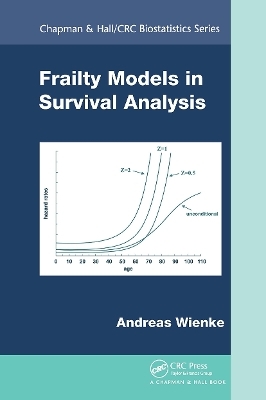
Frailty Models in Survival Analysis
Seiten
2024
Chapman & Hall/CRC (Verlag)
978-1-032-92206-5 (ISBN)
Chapman & Hall/CRC (Verlag)
978-1-032-92206-5 (ISBN)
Accessible to nonspecialists, this book explains the basic ideas in frailty modeling and statistical techniques, with a focus on real data application and interpretation of the results. It extensively explores how univariate frailty models can represent unobserved heterogeneity. It also emphasizes correlated frailty models as extensions of univa
The concept of frailty offers a convenient way to introduce unobserved heterogeneity and associations into models for survival data. In its simplest form, frailty is an unobserved random proportionality factor that modifies the hazard function of an individual or a group of related individuals. Frailty Models in Survival Analysis presents a comprehensive overview of the fundamental approaches in the area of frailty models.
The book extensively explores how univariate frailty models can represent unobserved heterogeneity. It also emphasizes correlated frailty models as extensions of univariate and shared frailty models. The author analyzes similarities and differences between frailty and copula models; discusses problems related to frailty models, such as tests for homogeneity; and describes parametric and semiparametric models using both frequentist and Bayesian approaches. He also shows how to apply the models to real data using the statistical packages of R, SAS, and Stata. The appendix provides the technical mathematical results used throughout.
Written in nontechnical terms accessible to nonspecialists, this book explains the basic ideas in frailty modeling and statistical techniques, with a focus on real-world data application and interpretation of the results. By applying several models to the same data, it allows for the comparison of their advantages and limitations under varying model assumptions. The book also employs simulations to analyze the finite sample size performance of the models.
The concept of frailty offers a convenient way to introduce unobserved heterogeneity and associations into models for survival data. In its simplest form, frailty is an unobserved random proportionality factor that modifies the hazard function of an individual or a group of related individuals. Frailty Models in Survival Analysis presents a comprehensive overview of the fundamental approaches in the area of frailty models.
The book extensively explores how univariate frailty models can represent unobserved heterogeneity. It also emphasizes correlated frailty models as extensions of univariate and shared frailty models. The author analyzes similarities and differences between frailty and copula models; discusses problems related to frailty models, such as tests for homogeneity; and describes parametric and semiparametric models using both frequentist and Bayesian approaches. He also shows how to apply the models to real data using the statistical packages of R, SAS, and Stata. The appendix provides the technical mathematical results used throughout.
Written in nontechnical terms accessible to nonspecialists, this book explains the basic ideas in frailty modeling and statistical techniques, with a focus on real-world data application and interpretation of the results. By applying several models to the same data, it allows for the comparison of their advantages and limitations under varying model assumptions. The book also employs simulations to analyze the finite sample size performance of the models.
Andreas Wienke is a docent in the Institute of Medical Epidemiology, Biostatistics, and Informatics at Martin-Luther-University Halle-Wittenberg in Germany. In addition to statistical consulting and teaching courses on biostatistics and epidemiology, Dr. Wienke plans, designs, and supervises clinical trials in the University’s Coordination Centre of Clinical Trials.
Introduction. Survival Analysis. Univariate Frailty Models. Shared Frailty Models. Correlated Frailty Models. Copula Models. Different Aspects of Frailty Modeling. Appendix. References. Index.
| Erscheinungsdatum | 16.10.2024 |
|---|---|
| Reihe/Serie | Chapman & Hall/CRC Biostatistics Series |
| Zusatzinfo | 22 Illustrations, black and white |
| Sprache | englisch |
| Maße | 156 x 234 mm |
| Gewicht | 598 g |
| Themenwelt | Medizin / Pharmazie |
| Naturwissenschaften ► Biologie | |
| Technik | |
| ISBN-10 | 1-032-92206-0 / 1032922060 |
| ISBN-13 | 978-1-032-92206-5 / 9781032922065 |
| Zustand | Neuware |
| Haben Sie eine Frage zum Produkt? |
Mehr entdecken
aus dem Bereich
aus dem Bereich
was Mikroben, Tiere und Pflanzen eint und wie sie uns ernähren
Buch | Softcover (2024)
Lenos (Verlag)
CHF 31,95
was wir alle wissen sollten
Buch | Softcover (2023)
Mitteldeutscher Verlag
CHF 33,55


